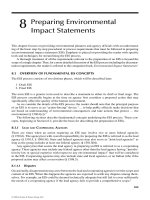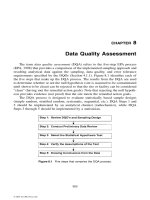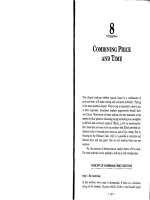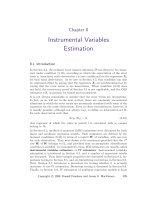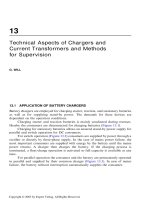Personality classic theories and modern research 6th chapter 8 trait aspects of personality
Bạn đang xem bản rút gọn của tài liệu. Xem và tải ngay bản đầy đủ của tài liệu tại đây (240.65 KB, 32 trang )
Personality
Sixth edition
Chapter 8
Trait Aspects of
Personality
Copyright © 2015, 2012, 2009 Pearson Education, Inc. All Rights Reserved
Modules
Introduction: Trait Aspects of Personality
8.1: The History of Trait Approaches
8.2: Gordon Allport’s Trait Psychology
8.3: The Big Five
8.4: Personality Judgments
8.5: Types
8.6: Motives
8.7: Expressive Style
Conclusion: Trait Aspects of Personality
Copyright © 2015, 2012, 2009 Pearson Education, Inc. All Rights Reserved
Learning Objectives (1 of 2)
8.1: Evaluate the development of different approaches to analyzing traits
8.2: Analyze the claims made by Gordon Allport’s trait psychology
8.3: Examine the five dimensions of the most common trait approaches to personality
8.4: Examine how people judge the personalities of other people
Copyright © 2015, 2012, 2009 Pearson Education, Inc. All Rights Reserved
Learning Objectives (1 of 2)
8.5: Review the concept of personality types
8.6: Use the concept of motive to understand personality
8.7: Scrutinize the relationship between personality and expressive style
Copyright © 2015, 2012, 2009 Pearson Education, Inc. All Rights Reserved
Introduction: Trait Aspects of Personality?
•
Different approaches to analyzing traits
•
Five dimensions of most common trait approaches to personality
Copyright © 2015, 2012, 2009 Pearson Education, Inc. All Rights Reserved
8.1: The History of Trait Approaches
Objective: Evaluate the development of different approaches to analyzing traits
Traits for characters in stories
Greek contribution
Modern approaches
Copyright © 2015, 2012, 2009 Pearson Education, Inc. All Rights Reserved
8.1.1: Jung’s Extroversion and Introversion
•
Trait approaches
•
Myers-Brigg Type Indicator
Copyright © 2015, 2012, 2009 Pearson Education, Inc. All Rights Reserved
8.1.2: The Use of Statistics
•
Factor analysis
•
Cattell’s approach
Copyright © 2015, 2012, 2009 Pearson Education, Inc. All Rights Reserved
8.1.3: Q-data,T-data, L-data, and the 16PF
•
Q-data
•
T-data
•
L-data
Copyright © 2015, 2012, 2009 Pearson Education, Inc. All Rights Reserved
8.2: Gordon Allport’s Trait Psychology
Objective: Analyze the claims made by Gordon Allport’s trait psychology
Allport’s first meeting with Freud
Allport’s approach
Copyright © 2015, 2012, 2009 Pearson Education, Inc. All Rights Reserved
8.2.1: The Importance of Culture
•
Studying prejudice
•
Studying cultural influences on personality
Copyright © 2015, 2012, 2009 Pearson Education, Inc. All Rights Reserved
8.2.2: Functional Equivalence
•
Drawbacks of factor analysis
•
Allport’s solution
Copyright © 2015, 2012, 2009 Pearson Education, Inc. All Rights Reserved
8.2.3: Common Traits
•
Common biological heritage
•
Childhood experiences
Copyright © 2015, 2012, 2009 Pearson Education, Inc. All Rights Reserved
8.2.4: Personal Dispositions
•
Idiographic methods
•
Nuclear quality
•
What is personal disposition?
Copyright © 2015, 2012, 2009 Pearson Education, Inc. All Rights Reserved
8.3: The Big Five
Objective: Examine the five dimensions of the most common trait approaches to personality
Extroversion
Agreeableness
Conscientiousness
Neuroticism
Openness
Copyright © 2015, 2012, 2009 Pearson Education, Inc. All Rights Reserved
8.3.1: How Was the Big Five Model Developed?
•
Overview
•
Factor analysis
Copyright © 2015, 2012, 2009 Pearson Education, Inc. All Rights Reserved
8.3.2: Career Pathways and Other Important Outcomes
•
Extroverts
•
Conscientiousness
•
Agreeableness
•
Entrepreneurs
Copyright © 2015, 2012, 2009 Pearson Education, Inc. All Rights Reserved
8.3.3: More Than Five? Fewer Than Five?
•
Derived from new knowledge
•
Cattell’s scheme
Copyright © 2015, 2012, 2009 Pearson Education, Inc. All Rights Reserved
8.3.4: Eysenck’s Big Three and Related Alternatives
•
Hans Eysenck
•
Eysenck’s theory
Copyright © 2015, 2012, 2009 Pearson Education, Inc. All Rights Reserved
8.3.5: Evidence for Eysenck’s Approach
•
Study: Zuckerman, Joireman, Kraft, & Kuhlman, 1999
•
Point 2: Study: Wilt & Revelle, 2009
•
Point 3: Study: Lucas & Diener, 2001
•
Point 4: Study: Canli, 2006; Canli et al., 2001
Copyright © 2015, 2012, 2009 Pearson Education, Inc. All Rights Reserved
8.4: Personality Judgments
Objective: Examine how people judge the personalities of other people
Love at first sight
Implications
Copyright © 2015, 2012, 2009 Pearson Education, Inc. All Rights Reserved
8.4.1: Consensus in Personality Judgments
•
Strangers making judgments
•
Self-rating
•
Peers and friends making judgments
Copyright © 2015, 2012, 2009 Pearson Education, Inc. All Rights Reserved
8.4.2: Limits of Trait Conceptions
•
Other aspects that affect
•
Are professionals better?
Copyright © 2015, 2012, 2009 Pearson Education, Inc. All Rights Reserved
8.5: Types
Objective: Review the concept of personality types
Different types of personality
Type theories
Copyright © 2015, 2012, 2009 Pearson Education, Inc. All Rights Reserved
8.6: Motives
Objective: Use the concept of motive to understand personality
What are motives?
Types of needs
Copyright © 2015, 2012, 2009 Pearson Education, Inc. All Rights Reserved


